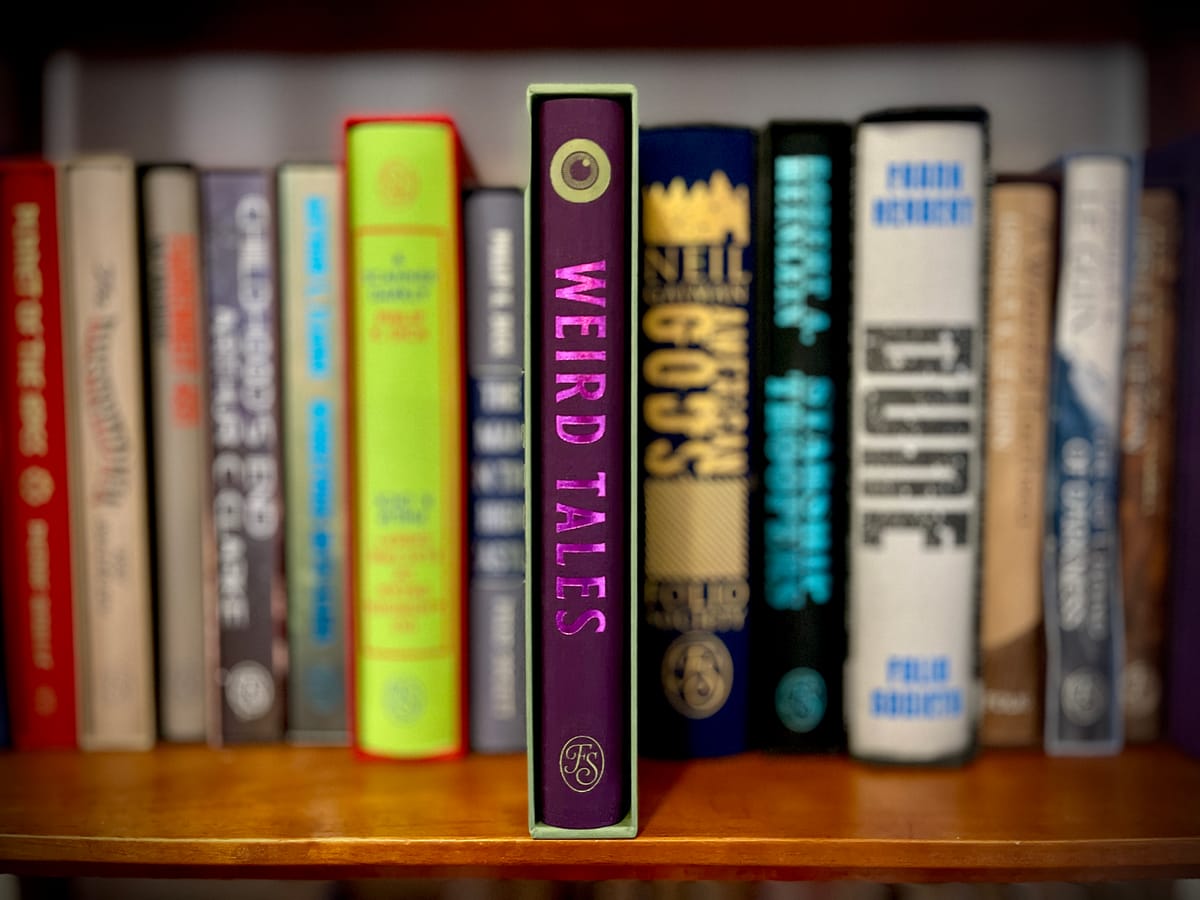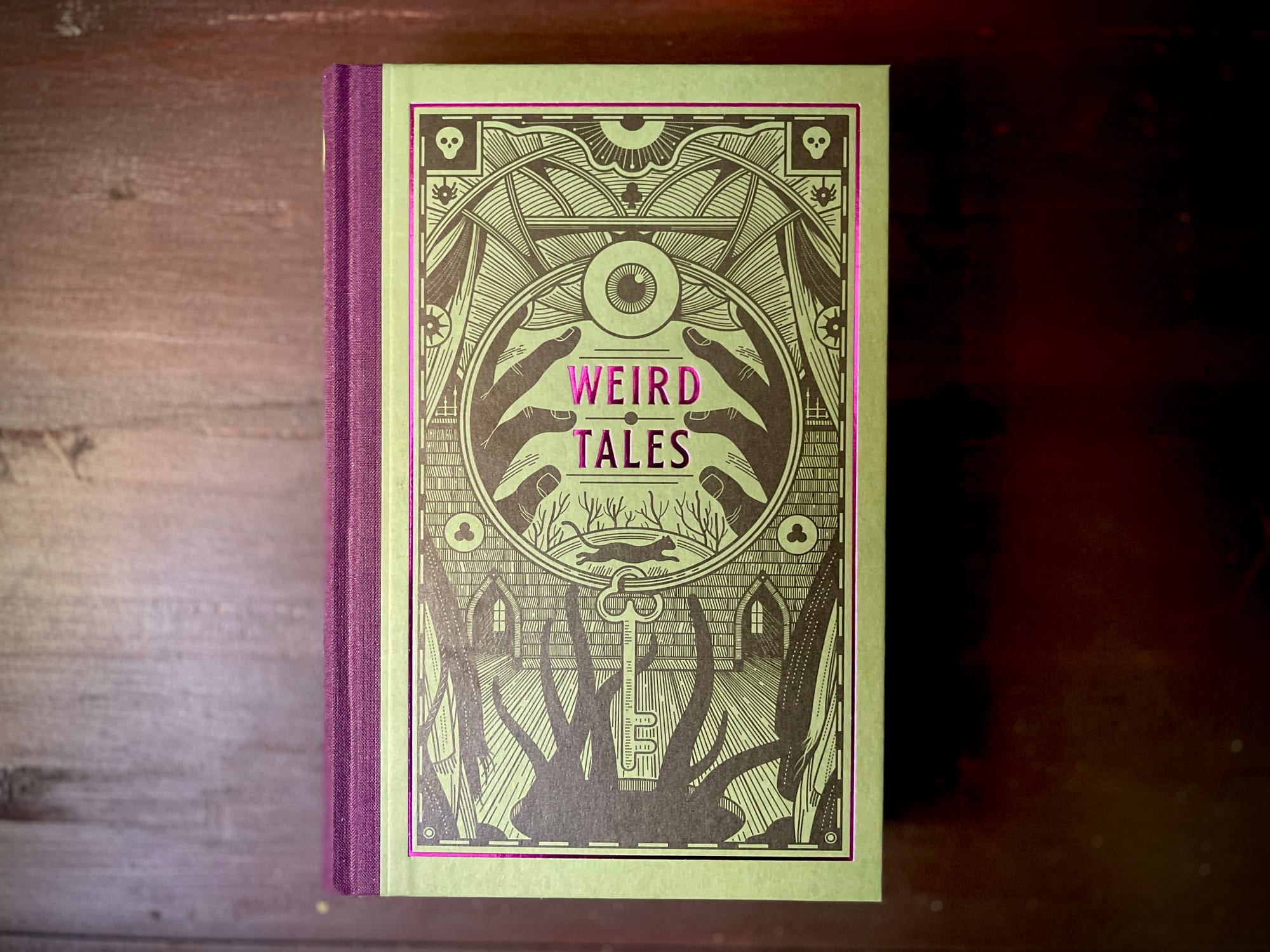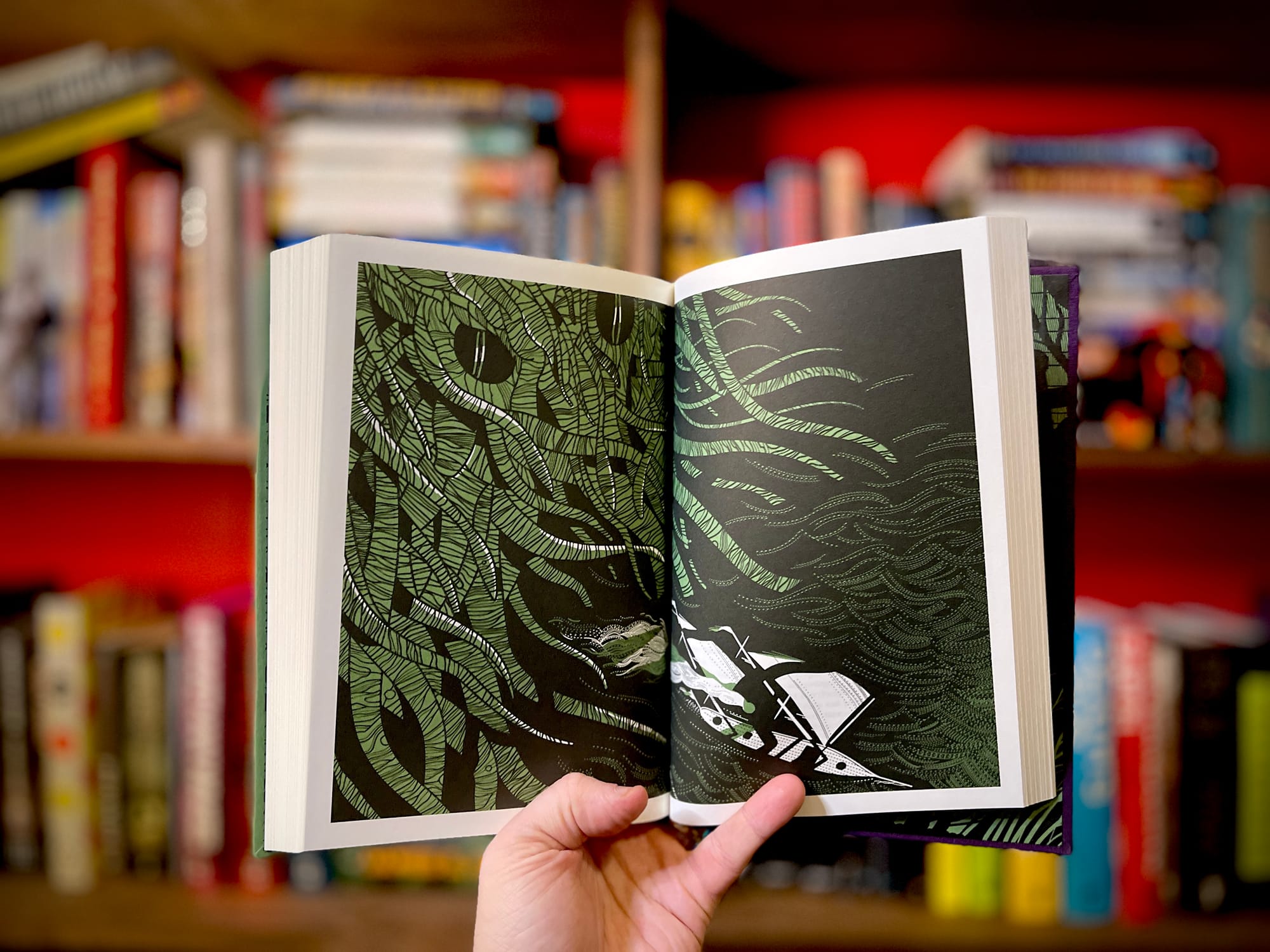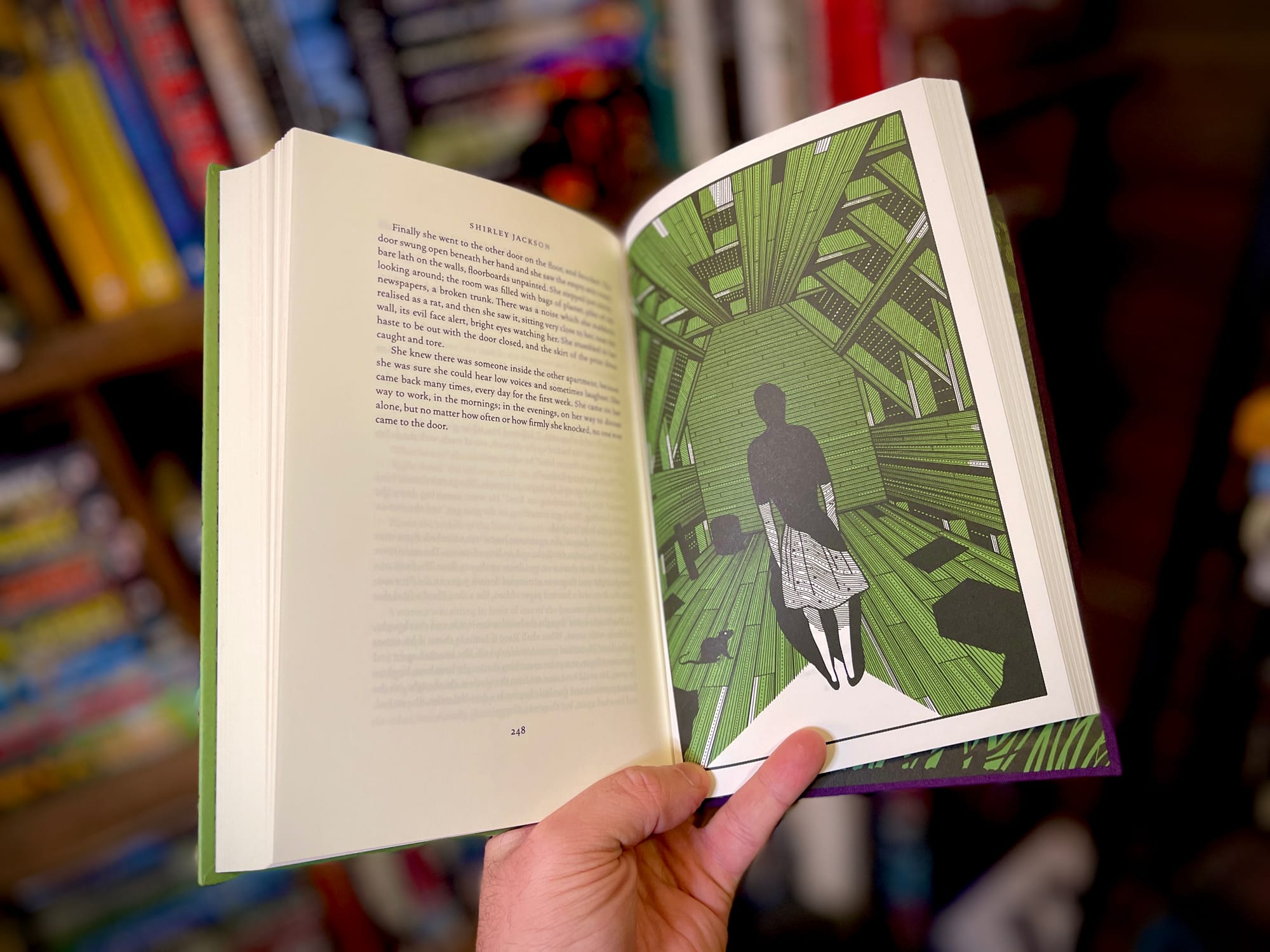Scary stories
An interview with Michael Dirda about his Folio Society collection, Weird Tales

In March, The Folio Society released its 2024 Spring Collection, which included Stephen Ambrose's WWII history, Band of Brothers and a new collection of horror stories called Weird Tales, assembled by noted critic Michael Dirda.
In his introduction, Dirda explains that the stories he brought together for this volume are ones that he considers the genre's high points. That table of contents includes the likes of Arthur Machen, Algernon Blackwood, M.R. James, H.P. Lovecraft, Shirley Jackson, and more, stretching from the 19th to the 21st century.
Like most of the Folio Society's offerings, this is a handsome volume. With its green and purple color scheme, this book reminds me quite a bit of the company's 2017 release, The Call of Cthulhu & Other Weird Stories, a selection of stories by H.P. Lovecraft, which oozes with an uncanny and off-kilter feel when you hold it. It features a handful of original illustrations from artist Harry Campbell, who uses a stark green-and-black woodcut motif for each of the images. It'll make for an excellent book to break out later this fall around Halloween.
I had the opportunity to speak with Dirda about his work assembling this volume. Folio Society provided this volume for review purposes.

Can you tell me a bit about your own interest in genre fiction? What are your early memories of the weird horror or speculative stories, and what keeps you interested in reading them?
I've always been drawn to adventure fiction, plot-driven stories, novels in which things happen. When I was in high school, my French teacher lent me his Arkham House editions of H.P. Lovecraft stories, which I found irresistible, partly because of the prose’s delicious portentousness but also because of the rewriting of earth's history and their surprise endings. In these same years, I read with fear and trepidation various Alfred Hitchcock collections with titles like "Stories That Scared Even Me." One lucky afternoon, I even discovered a copy of Lord Dunsany's "Jorkens Remembers Africa" in my school library, misfiled under Travel. These are tall tales, most of them fantastic and set down in lovely prose, recounting the youthful adventures of the now old and world-weary clubman Jorkens. I loved them. Not least, from the library I would check out anthologies such as Wise and Fraser's classic "Great Tales of Terror and the Supernatural" and Bennett Cerf's "Best Ghost Stories."
Much later, in graduate school I would study medieval European literature, which is replete with bogies, heroes, and magic of various kinds. After I came to The Washington Post, I convinced my masters that Book World should carry a monthly fantasy and science fiction column. Put in charge of this, I wrote to and exchanged letters with the only SF author I knew, Joanna Russ, who brought me up to date on the field and alerted me to the writers and critics I might ask to contribute to the column. I attended the 1980 Worldcon in Boston–and since then many other SF, fantasy and horror cons–as I grew increasingly familiar with the richness and range of "fantastika."
During these same years, I was rediscovering Sherlock Holmes, eventually being invested into The Baker Street Irregulars. Two of my fellow Irregulars, Barbara and Christopher Roden, happened to operate Ash-Tree Press, which specialized in reissuing classic supernatural literature. They asked me to write an introduction to an Ash-Tree volume of Conan Doyle's strange stories titled The Captain of the Pole-Star. Around the same time, the Rodens published A Pleasing Terror, a huge volume of everything M.R. James wrote in the way of a ghost story or a commentary on ghost stories. Reading both Conan Doyle and James made me eager for more tales of the uncanny. I later reviewed Ash-Tree collections devoted to Sheridan Le Fanu and Vernon Lee. The latter's "Amour Dure" is my favorite ghost story.
After bringing out a little book called On Conan Doyle, I decided to build on this and write a kind of survey–an appreciation really–of the popular fiction of late 19th and early 20th-century Britain, essentially the period that established the templates for modern "genre literature." I've been working on it for some time, and am now revising the manuscript, which includes–to name just a few–writers such as Robert Louis Stevenson, Oscar Wilde, E. Nesbit, Vernon Lee, H.G. Wells, Rider Haggard, E.F. Benson, Saki, and J.M. Barrie, all of whom produced excellent ghost stories and weird tales.
I could go on, but let me finish this overlong reply by mentioning the deeper reason I enjoy weird tales, as well as classic mysteries, swashbucklers, and fantasy of all kinds. Too much modern fiction seems confessional and moralistic, regularly focusing on adolescent angst, unhappy families, sexual and identity confusions, societal injustice, spiritual redemption and earnest accounts of the way we live now. To borrow a phrase from the great bookman Vincent Starrett, I like stories in which things happen and then keep on happening.

In your introduction, you explained that this collection is what you'd consider the cultural touchstones of uncanny fiction, and that they're stories that often contain the supernatural and make you question the fabric of reality around us. What are the ideal ingredients that go into this type of weird horror?
Science fiction is famously said to extrapolate from the present moment, to take some contemporary phenomenon and apply the magic formula, "If this goes on..." Similarly, weird tales often raise the question "Can such things be?" Sometimes they answer with a definite yes, but many of the best keep the whole matter open-ended. Uncertainty might be the most prominent quality of the weird.
I myself prefer stories that subtly create a feeling of unease, an atmosphere of wrongness, a growing conviction that the quotidian world isn't what it seems at all. Sometimes a protagonist simply Goes Too Far into matters that he or she would have done better to ignore--and then pays the price. Sometimes, he or she is simply unlucky: "As flies to wanton boys are we to the gods, they kill us for their sport."
I have no belief in the occult or supernatural myself, but while I'm reading any of the contributions to "Weird Tales" I find myself falling under the spell of their uncanny atmospheres, their often heightened, even hysterical prose styles, the sheer audacity of their authors' imagination.

The first story in this book is Shieridan le Fanu's "Strange Event in the Life of Schalken the Painter" from 1839, while the last is Mark Samuels' "The White Hands" from 2003. What scares us now can be different from what was frightening in the mid-19th century, but I'd be interested in knowing what you think has remained consistent in the genre over that course of time.
I'm not sure that frightening the reader is really what, deep down, these stories aim to do. Yes, some can be gruesome–raw head and bloody bones–while others depict psychological deterioration or end with a short, sharp shock. But, at heart, weird tales aim to leave you wondering about yourself, the nature of what we call reality, the pathos inherent in mortality. Most, too, are carefully, artfully constructed, satisfying our human thirst for Story and our particular delight in Wonders of all kinds.
What one does notice in the selections for Weird Tales is the author's awareness that he or she is contributing to an established literary tradition. Many people dislike Robert Aickman's "strange stories" because of the unresolved ambiguities that lie at their heart, but there's no doubt about Aickman's self-awareness and sophistication. Two of the stories in "Weird Tales" are not only unsettling but also deeply metafictional. Karl Edward Wagner's "Sticks" plays off the entire history of Lovecraftian weird fiction; Mark Samuels's "The White Hands" overtly pays homage to Arthur Machen, Algernon Blackwood and others in the British tradition of the forbidden and occult. In this way, they honor, continue and subvert the genre they love and work in.
Weird Tales is now available and retails for $75.